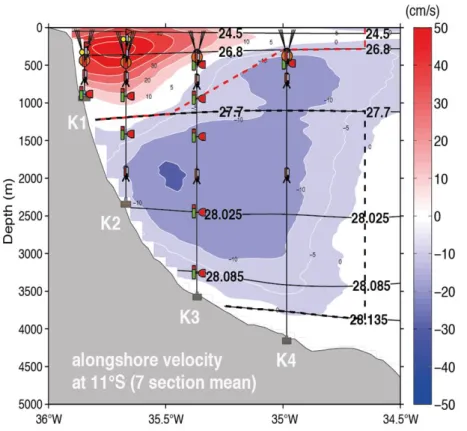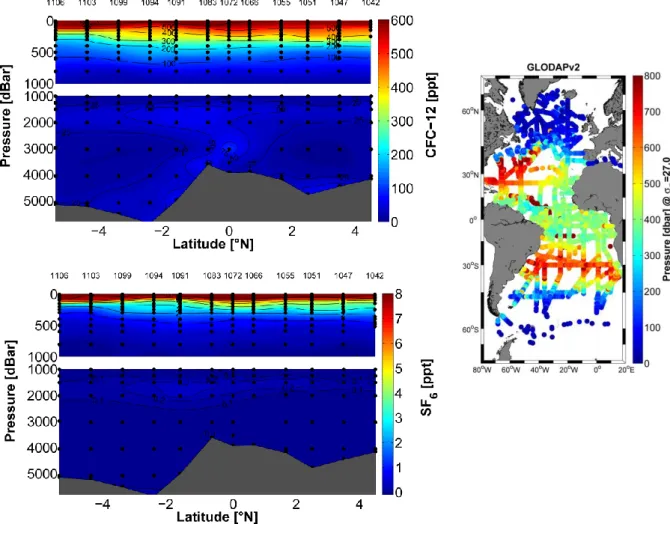Dr. Marcus Dengler Meteor Reise M130
M130, Mindelo – Recife
August 28th to October 3rd, 2016 5th Weekly Report, September 25th, 2016
After a two day transit ending on Wednesday, we have started our observational program in the western boundary region off Brazil at 11°S. Our activities focussing on the determining the strength and variability of the western boundary circulation were very successful. We were able to recover and redeploy all four moorings (Fig. 1) and were very happy about the returned data sets. 37 of the 38 instruments mounted to the moorings recorded full data sets and in particular, all current meter had functioned correctly.
Our investigations off Brazil are part of the BMBF cooperative project “Regional Atlantic circulation and global change" (RACE). The data from the moorings as well as the shipboard measurements are used to determine the transport variability of the North Brazil Undercurrent in the upper 1000m and the South Atlantic Deep Western Boundary Current situated between 1000m and 4000m depth (Fig. 1). Both currents are essential components of the meridional overturning circulation. The North Brazil Undercurrent transports warm water originating from the Southern Hemisphere subtropics and the Indian Ocean northward across the equator. Via the Gulfstream these waters enter the North Atlantic where they sink and form the North Atlantic Deep Water. Finally, the Deep Western Boundary Current carries the North Atlantic Deep Water southward across the equator, where it reaches the continental slope off Brazil.
Fig. 1: Average alongshore velocity off Brazil at 11°S.
Red contours indicate northward velocities in the North Brazil Undercurrent.
Blue contours show southward velocities associated with the deep western boundary current.
Mooring positions (K1 to K4) and distribution of the
instruments along the moorings are additionally shown. (Plot: Rebecca Hummels)
Dr. Marcus Dengler Meteor Reise M130
Our mooring array at the western boundary that is in operation since July 2013, and the shipboard observations thus capture an essential part of the basin-scale meridional overturning circulation. Our aim is to determine interannual to decadal variability of the currents as well as the variability of the water masses exchanged between the two Hemispheres.
Transient tracers along 23°W
In addition to physical measurements, chemical measurements of transient tracers performed during the cruise help us to advance understanding of the circulation and the pathways of water masses in the ocean. The transient tracer field work consists of three major working areas. Apart from the tracer release survey that was reported in the 3rd weekly report, the concentrations of chlorofluorocarbon (CFC-12) and sulphur hexafluoride (SF6) in the water column are measured (Fig. 2) using purge and trap gas chromatography. Both of these so called “transient tracers” enter the ocean via gas-exchange at the air-sea interface only. The tracers are then transported into ocean interior via ventilation processes such as deep water formation in the North Atlantic or subduction processes in the subtropical gyres. The
Abb. 2: Partial pressure distribution of CFC-12 (upper left panel) and SF6 (lower left panel) in 10-12 parts (ppt - parts per trillion) along 23°W. The right panel shows the distribution of available transient trace gas (CFC-12) data in global inventories. Colour code represents pressure of the isopycnal surface =27.0 m3 kg-1. Blue regions represent water mass formation regions. (Plots: Tim Stöven).
Dr. Marcus Dengler Meteor Reise M130
atmospheric concentration histories of such tracers provide time information which can be used to determine different types of “age” of a water parcel. CFC-12 and SF6
have distinct differences in their atmospheric history. CFC-12 has been released into the atmosphere since the late 1920s, whereas SF6 is produced on an industrial scale since the beginning of the 1950s. Therefore, the CFC-12 tracer can already be found in less ventilated water masses contrary to the SF6 tracer, which is mostly absent in such ocean regions (Fig. 2).
When combined with circulation models, the time information of the transient tracers allow calculation of additional parameters, such as the anthropogenic carbon content in the water column and oxygen utilization rates. The latter is of particular interest for the understanding of oxygen minimum zones and their development in the future. On the other hand, our measurements contribute to the global data set of transient tracers in the Atlantic sector of the world ocean (Fig. 2). Based on this data collection, it is possible to track water parcels from their formation regions along their pathways into the oxygen minimum zone of the eastern north Atlantic providing additional information about the oxygen budget as well as the oxygen utilization rates.
We will have completed our ship-board measurements and mooring activities along 11°S by Monday evening. After a transit of 1.2 days, we will continue our measurement program in the western boundary region at 5°S.
Best regards from the tropical south Atlantic,
Marcus Dengler and the participants of M130

